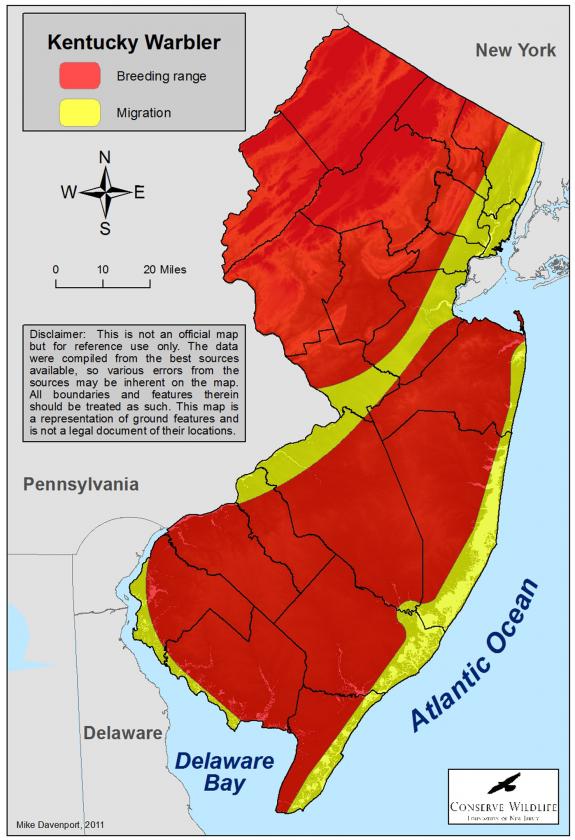Oporornis formosus
Type: bird
Status: special concern
Species Guide
Kentucky warbler
Oporornis formosus
Species Type: bird
Conservation Status: special concern
IDENTIFICATION
The Kentucky warbler is a small migratory songbird about 5 ½ inches in length. It has an olive-green back, dark cap, and yellow breast. It has broad black “sideburns” which extend downward from the eyes on the head. Both sexes look similar.
This species may be confused with the Canada warbler or the common yellowthroat which are similar in appearance. The Canada warbler has a dark necklace and lacks the dark sideburns whereas the yellowthroat has a black mask rather than sideburns.
The song of the Kentucky warbler also assists with its identification since this species is more often heard than seen. It is a rapid rolling tory-tory-tory-tory or churry-churry-churry-churry, similar to the song of a Carolina wren but lower in pitch.

Distribution & Habitat
The breeding range of the Kentucky warbler extends from southern New York in the north to Alabama and northern Florida in the south and as far west as eastern Kansas. It winters in northern South America, Central America, eastern Mexico, and the Caribbean.
Breeding habitat includes wet deciduous forest, dense second growth, and swamps. They prefer forests which have a dense understory. During the winter, they most commonly occupy wet forests.
Diet
Kentucky warblers feed on small invertebrates such as insects and spiders. They usually feed on or near the ground, often turning over leaves while searching for prey.
Life Cycle
The breeding season for the Kentucky warbler in New Jersey is between early May and mid-August. This species nests on or very near the ground, at the base of a tree or shrub or within a patch of weeds. Nests are built by both sexes and are a loose, bulky cup which may consist of dead leaves, grass, weed stems, bark, and rootlets. Between 3 to 6 eggs are laid in May or June and incubation by the female alone lasts about 12 days. The young are tended to by both parents.
Current Threats, Status, and Conservation
The Kentucky warbler has undergone a decline in population in recent years throughout portions of its range. Such declines are may be due to a number of factors including forest fragmentation, brood parasitism by cowbirds, loss of understory due to overgrazing by deer, and predation of nests. It is listed as a Species of Special Concern in New Jersey (not yet endangered or threatened but possibly on its way).
Preservation of large intact forest with dense understory benefits this species. Conservation of New Jersey’s warbler species requires long-term monitoring and research, habitat preservation and restoration, cowbird control, and incentives to promote habitat preservation within their wintering areas.
References
Text written by Michael J. Davenport in 2011.
Scientific Classification
- Kingdom: Animalia
- Phylum: Chordata
- Class: Aves
- Order: Passeriformes
- Family: Parulidae
- Genus: Oporornis
- Species: O. formosus